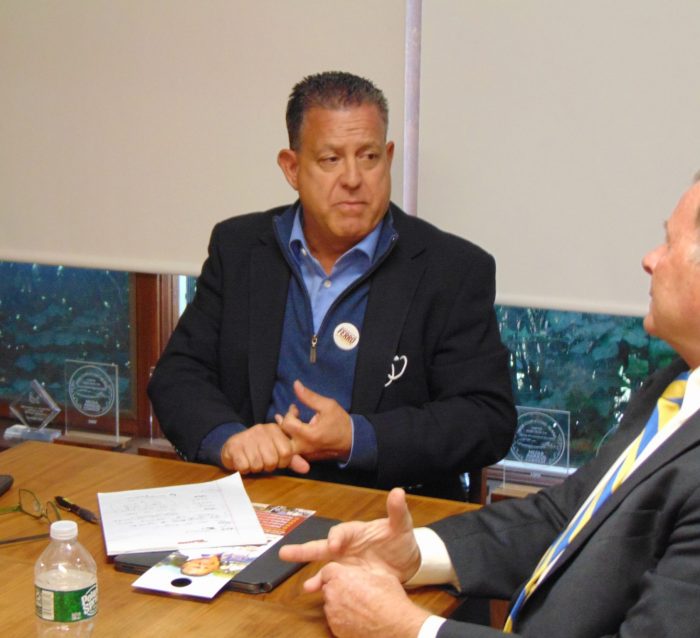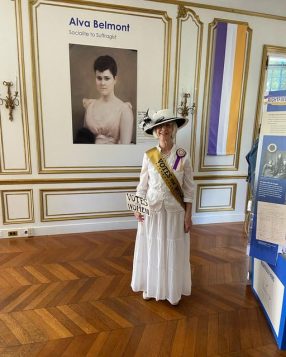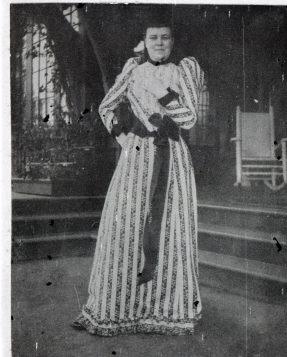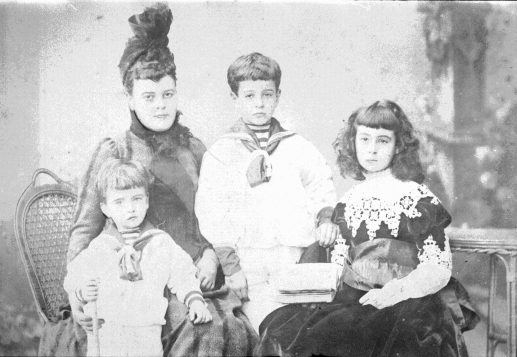By Tara Mae
Suffolk County Vanderbilt Museum’s new exhibit, Alva Belmont: Socialite to Suffragist, traces Alva Vanderbilt Belmont’s evolution from Alabama belle to New York suffragist.
Originally planned for 2020 as a centennial celebration of the ratification of the 19th Amendment, it is on display in the Vanderbilt Mansion’s Lancaster Room on the first floor and offers an overview of Alva’s life while highlighting her fervent support for the women’s suffrage movement.
“Alva Vanderbilt Belmont was the mother of William K. Vanderbilt II, who built the estate, mansion, and museum,” said Executive Director Elizabeth Wayland-Morgan. Alva’s first husband, William II’s father, was the grandson of Cornelius Vanderbilt, a business tycoon who amassed his wealth through railroads and shipping.
From a prominent Southern family, Alva brought her own money and social standing into the marriage and later used her position to fight for women’s rights.
“As a Southern socialite, she became an unexpected champion of women’s rights. Alva gave important support and funding to the National American Woman Suffrage Association and several women’s suffrage groups in the U.S. and the United Kingdom,” Wayland-Morgan added. “Alva was in a position of considerable power, influence, and social connections. For such a woman in any era to take up the fight for the rights of all women was startling. I wanted to know more about her extraordinary life.”
The exhibit is set up in five sections: Early Life, First Foray, Marble House, The National Woman’s Party, and Later Life.
“Each section represents a pivotal moment in Alva’s life that shows how she became involved in the suffragist movement over time,” explained Archives and Records Manager Killian Taylor during a recent tour.
Primary sources and artifacts, including newspaper articles and “Votes for Women” plates commissioned by Alva, are on display and the Estate of Nan Guzzetta loaned 13 replicas of historic suffragist outfits to set the stage. The focal point of the exhibit is the photographs that adorn the walls.
Images are included from the museum’s collection, the Library of Congress, and the National Woman’s Party, as well as loaned from the Southampton History Museum. Port Jefferson Village historian Chris Ryon also provided prints. A video installation, sponsored by Bank of America, chronicles her life.
“It is primarily a photo-based exhibit; Alva’s life through photos. Alva was savvy about using the media to her advantage” said Taylor.
Featuring pictures of Alva’s private and public lives, photos depict Alva with her children, at her homes, such as Marble House in Rhode Island (site of her “Conference of Great Women”), and with her fellow suffragists, among them Alice Paul and Lucy Burns.
Taylor’s favorite images pertain to Alva’s work with the suffrage movement.
“The first is a photo of Alva, Alice Paul, and a number of members of the National Woman’s Party; everyone is centered around Alva, who is sitting at a desk that belonged to Susan B. Anthony. The second is a photo of Alva’s funeral in 1933; the mausoleum is a replica of one designed by da Vinci. Alva’s pallbearers were all women and her casket flanked by members of National Woman’s Party,” he said.
Recognizing the influence of her social capital, Alva leveraged it for promoting women’s suffrage. Any event, even her own funeral, could be used for publicity.
“One of Alva’s strong points was that she was very, very good at using the press, so when she became heavily involved in the movement she made sure that she got in the papers,” Taylor said.
Alva joined the National American Woman Suffrage Association circa 1909, following the death of her second husband, Oliver Belmont, and quickly put to good use the connections she had initially fostered while married to her first husband, William Kissam Vanderbilt.
Alva networked, hosted events, organized, founded the Political Equality Union of New York to elect candidates who supported women’s suffrage, created a new national press bureau, worked the press, and with Paul even arranged the first picket protest to be held outside the White House.
As a leader of women’s suffrage, Alva was advocating for women to have power beyond what was allocated to them by the men in their lives. Before women had the right to vote, their primary access to power was through their husbands (or fathers.)
And so, prior to her participation in the women’s suffrage movement, Alva sought authority through the means most available to her: making a socially and economically suitable marriage for herself. Alva understood the importance of a “good match,” as Taylor noted, and with William K. Vanderbilt, she made one.
“Their marriage was pragmatic; it was not a love match,” he added. “For an American woman who wanted independence during the 19th century, the option was to marry rich.”
William was certainly rich; he was part of the wealthiest family in the country. He and Alva had three children: Consuelo, William, and Harold.
Alva divorced William Sr. for having an affair, at the time an uncommon response to such behavior.
“She is the one who suffered the backlash,” Taylor said. Still, she emerged with several of their estates and a financial settlement reportedly in the range of $10 million.
Her second marriage, to Oliver Belmont, was by all accounts a happier union. In 1908, her husband died of appendicitis and Alva fell into a depression. To cope, she immersed herself in charitable works and causes, which led her to the women’s suffrage movement.
“At Consuelo’s urging, she attended a suffrage event in the United Kingdom and that lit the spark,” Taylor said.
Consuelo was involved in the women’s suffrage movement in England, and the two pooled their resources and clout for women’s suffrage in the United States. They had reconciled after a rift caused years earlier by Alva’s machinations in arranging Consuelo’s marriage.
She selected Charles Spencer-Churchill, Duke of Marlborough, as Consuelo’s husband. Alva apparently saw the union as an opportunity for further upward mobility and international social standing. Consuelo refused to wed him, wanting instead to elope with her secret fiancé, Winthrop Rutherford.
In retaliation, Alva had her locked in her room and threatened to shoot Rutherford. “Alva was very strong-willed,” Taylor said. Consuelo continued to resist until Alva emotionally blackmailed her into compliance, feigning she was dying of a heart ailment to get her then seventeen year old daughter to acquiesce. On the day of the wedding, while Consuelo reputedly wept behind her veil, Alva appeared to have made an immediate and full recovery.
A little over a decade into the marriage, Consuelo and Charles separated. They later divorced and sought an annulment, with Alva’s full support. During the process, Alva told an investigator “I forced my daughter to marry the duke.”
The common goal of women’s suffrage helped heal the once frayed relationship between the two women, and as Consuelo worked abroad, Alva, with the National Woman’s Party, sought a constitutional amendment to guarantee women the right to vote in the United States.
Victory came in 1920 with the ratification of the 19th Amendment. Alva then moved to France to be near Consuelo. She died there in 1933 and is interred in the Belmont Mausoleum at Woodlawn Cemetery in the Bronx.
“The museum is proud of Alva’s national leadership role as a champion of women’s rights, as was her family. Her success in the suffrage movement and in securing the right of women to vote is a significant, pivotal chapter in American history,” Wayland-Morgan said.
The Suffolk County Vanderbilt Museum, 180 Little Neck Road, Centerport presents Alva Belmont: Socialite to Suffragist through mid-January 2022. Tickets to the museum are $10 for adults, $9 for seniors, $9 for students with ID, and $7 for children age 12 and younger) Children under the age of two are free. Current hours for the museum, mansion and planetarium are Friday to Sunday from noon to 4 p.m. For more information, call 631-854-5579 or visit www.vanderbiltmuseum.org.





















































